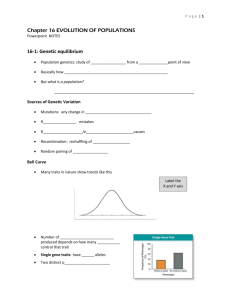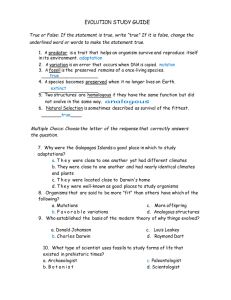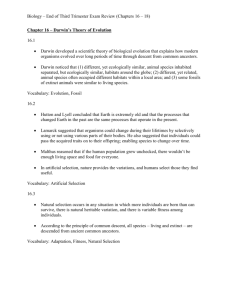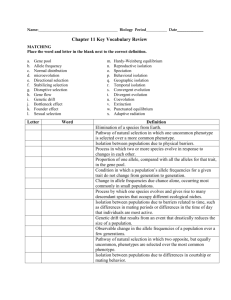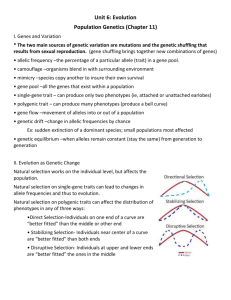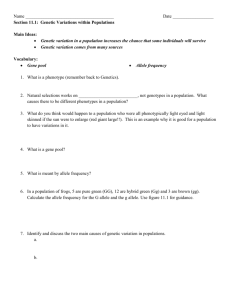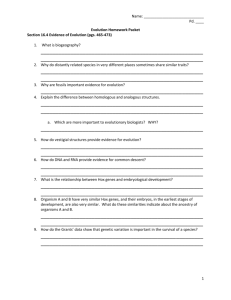Evolution
advertisement
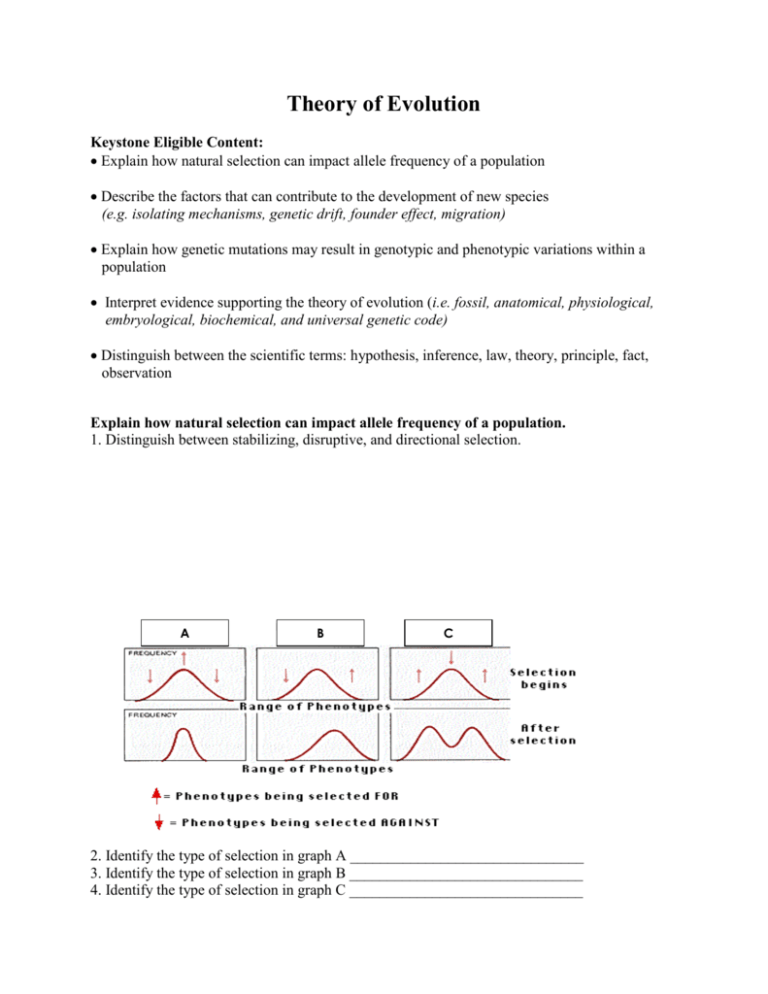
Theory of Evolution Keystone Eligible Content: Explain how natural selection can impact allele frequency of a population Describe the factors that can contribute to the development of new species (e.g. isolating mechanisms, genetic drift, founder effect, migration) Explain how genetic mutations may result in genotypic and phenotypic variations within a population Interpret evidence supporting the theory of evolution (i.e. fossil, anatomical, physiological, embryological, biochemical, and universal genetic code) Distinguish between the scientific terms: hypothesis, inference, law, theory, principle, fact, observation Explain how natural selection can impact allele frequency of a population. 1. Distinguish between stabilizing, disruptive, and directional selection. A B C 2. Identify the type of selection in graph A _______________________________ 3. Identify the type of selection in graph B _______________________________ 4. Identify the type of selection in graph C _______________________________ 5. In a species of snail, dark individuals are better hidden (from bird predators) in the shady forest, while lighter individuals are better hidden in well lit brushy edge areas. There are no areas of intermediate brightness; therefore, ___________ acts on shell color in these snails. a. directional selection b. disruptive selection c. stabilizing selection 6. Small Aristelliger lizards have difficulty defending territories, but large lizards are more likely to be preyed upon by owls. This situation results in ________ on adult body size. a. directional selection b. disruptive selection c. stabilizing selection 7. Long necks make it easier for giraffes to reach leaves high on trees, while also making them better fighters in "neck wrestling" contests. In both cases, __________ appears to have made giraffes the long-necked creatures they are today. a. directional selection b. disruptive selection c. stabilizing selection Describe the factors that can contribute to the development of new species (e.g. isolating mechanisms, genetic drift, founder effect, migration) 8. Types of Reproductive Isolation: Behavioral Isolation Geographic Isolation Temporal Isolation 9. Populations of the same species of seal live on islands too far apart to swim between them for mating. a. behavioral isolation b. temporal isolation c. geographic isolation 10. Species of birds have elaborate courtship dances, and females select the best dancers as mates. a. behavioral isolation b. temporal isolation c. geographic isolation 11. Varieties of oak tree produce pollen during different seasons, so they can’t pollinate one another. a. behavioral isolation b. temporal isolation c. geographic isolation 12. Herds of caribou misinterpret each other’s mating behavior, so they fight instead of mating a. behavioral isolation b. temporal isolation c. geographic isolation 13. What is genetic drift? Explain how genetic mutations may result in genotypic and phenotypic variation within a population. Interpret evidence supporting the theory of evolution (i.e. fossil, anatomical, physiological, embryological, biochemical, & universal genetic code) 14. Define and give an example of each of the following terms: Vocabulary Description Example(s) Homologous Structure Analogous Structure Vestigial Structure 15. DNA sequences are often used to determine relationships between organisms. DNA sequences that code for a particular gene can vary, though organisms that are closely related will have very similar sequences. This table shows the amino acid sequences of 4 organisms. Human: C C A T A G C A C C T A Chimpanzee: C C A T A A C A C C T A Pig: C C A T G T A A A C G A Cricket: C C T A A A G G G A C G Based on these sequences, which two organisms are most closely related? An unknown organism is found in the forest and the gene is sequenced as follows: Unknown: C C A TGG AAT CGA What kind of an animal do you think this is? Distinguish between the scientific terms: hypothesis, inference, law, theory, principle, fact observation 16. Describe the relationship between a hypothesis, an inference and a theory. Assessment Anchor – Theory of Evolution: Explain how natural selection can impact allele frequency of a population. Use the circle graphs below to answer question 1. 1. The graphs illustrate change in a lizard population over time. Which process most likely led to the change in the lizard population? a. natural selection acting on a harmful trait b. natural selection acting on a beneficial trait c. natural selection acting on a dominant trait d. natural selection acting on a recessive trait 2. The frequency of an allele in a fly population changes from 89% to 20% after three generations. Which other events most likely occurred during the same time period? a. an environmental change and a fly population increase b. an environmental change and a fly population decrease c. interbreeding of flies with an invasive species and fly population speciation d. interbreeding of flies with an established local species and fly population speciation Use the graph below to answer question 3. 3. Tail length in mice varies within a population. Scientists observed change in the distribution of tail lengths in a mouse population over time. At the genetic level, what has most likely happened to the allele for the shortest tail lengths? a. The allele changed from being dominant to being recessive. b. The allele changed from being autosomal to being sex-linked. c. The allele became less frequent than the alleles for longer tail lengths. d. The allele began to code for long tail lengths instead of the shortest ones. Describe the factors that can contribute to the development of new species (e.g. isolating mechanisms, genetic drift, founder effect, migration). 4. In North America, the eastern spotted skunk mates in late winter, and the western spotted skunk mates in late summer. Even though their geographic ranges overlap, the species do not mate with each other. What most likely prevents these two species from interbreeding? a. habitat isolation c. geographic isolation b. gametic isolation d. reproductive isolation Explain how genetic mutations may result in genotypic and phenotypic variations within a population. 5. A mutation occurs in the genes that code for coat color in deer. Which change will most likely result from this mutation? a. a change in the selection pressures acting on coat color b. a change in the coat-color genes of deer predator species c. an increase in coat-color diversity in the population d. an increase in the number of genes for coat color in the population Interpret evidence supporting the theory of evolution (i.e. fossil, anatomical, physiological, embryological, biochemical, and universal genetic code) Use the illustrations below to answer question 6. 6. The skeletons of mammalian forelimbs represent variations of a structure that was present in their common ancestor. What has most likely caused the variation in forelimbs? a. changes in muscle structure c. trait formation due to behaviors b. changes in the genetic codes d. development of vestigial structures Use the table below to answer question 7. . 7. The gene COII is in the genome of many organisms. A comparison of the number of base differences between the COII gene in a rat and that of two other animals is shown. A. Based on the data, describe a possible evolutionary relationship between rats, mice, and cows. ______________________________________________________________________________ ______________________________________________________________________________ ______________________________________________________________________________ ______________________________________________________________________________ ______________________________________________________________________________ ______________________________________________________________________________ B. Describe how different organisms having a common gene such as COII supports the theory of evolution. ______________________________________________________________________________ ______________________________________________________________________________ ______________________________________________________________________________ ______________________________________________________________________________ ______________________________________________________________________________ ______________________________________________________________________________ C. The COII gene of a monkey has 203 base differences from the same gene in a rat and 201 base differences from the same gene in a mouse. Compare the evolutionary relationships between the monkey, the rat, and the mouse. ______________________________________________________________________________ ______________________________________________________________________________ ______________________________________________________________________________ ______________________________________________________________________________ ______________________________________________________________________________ ______________________________________________________________________________ Distinguish between the scientific terms: hypothesis, inference, law, theory, principle, fact, and observation. Use the table below to answer question 8. Student’s Observations of a Pond Ecosystem Quantitative Qualitative 37 fish and three frogs Leaves lie on the bottom of the pond 2 types of aquatic grass Water insects move along the water’s surface 12 small rocks and 1 medium rock All 3 frogs are sitting on a pond bank sand 8. A group of students measured a ten-square-meter section of a pond ecosystem and recorded observations. Which statement is a testable hypothesis? a. The frogs living in the pond represent a population b. Water is an abiotic component in the pond ecosystem c. If the fish are given more food, then they will be happier d. If the frogs are startled, then they will jump into the water


